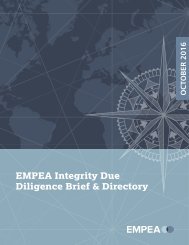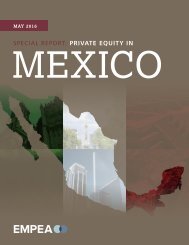You also want an ePaper? Increase the reach of your titles
YUMPU automatically turns print PDFs into web optimized ePapers that Google loves.
• The development <strong>of</strong> an onshore financial centre is<br />
not merely a matter <strong>of</strong> legality but largely a function <strong>of</strong><br />
cultural changes. Investors must feel confident in the<br />
region with respect to political stability and regulatory<br />
risks.<br />
• Whereas the location decisions <strong>of</strong> PE firms have<br />
significant impacts on the local economies, it appears<br />
domiciliation <strong>of</strong>fers considerably more modest benefits.<br />
We therefore suggest that it is more important for most<br />
African nations to focus on the development <strong>of</strong> PE<br />
activity in the region (i.e., local HQs and <strong>of</strong>fices) than<br />
on establishing an onshore financial centre for PE fund<br />
domiciliation.<br />
2. THE IMPORTANCE<br />
OF PRIVATE EQUITY IN<br />
FRONTIER MARKETS<br />
Enterprises in frontier markets face many challenges,<br />
including inadequate infrastructure, scarce management<br />
skills, competition from the informal sector, and corruption.<br />
Beyond these factors, recent data from the World Bank<br />
Enterprise Surveys suggest that 23.4% <strong>of</strong> firms in Sub-<br />
Saharan Africa (SSA) identified “access to finance” as the<br />
biggest obstacle to their establishment—the largest <strong>of</strong> all<br />
obstacles identified. 1<br />
Private equity is a critical form <strong>of</strong> risk capital—i.e., money<br />
contributed to high risk investments that have exceptional<br />
growth potential but also run the possibility <strong>of</strong> complete<br />
default—in frontier markets. On the firm level, PE <strong>of</strong>fers<br />
financially constrained firms a viable alternative to traditional<br />
debt financing, which is <strong>of</strong>ten unattainable. On the country<br />
level, PE investment can help create demonstration effects<br />
that can propel an economy forward, beyond the direct<br />
impact <strong>of</strong> the given investment. PE teams provide advice to<br />
the entrepreneurs in their portfolios, which builds domestic<br />
business capacity on a broad level. We discuss these<br />
benefits in more detail below.<br />
2.1. Firm-level Benefits <strong>of</strong> Private<br />
Equity Participation<br />
Risk capital in the form <strong>of</strong> PE can alleviate financial barriers<br />
to growth for SSA firms for which bank loans are extremely<br />
difficult to obtain. Bank financing in frontier markets is<br />
impeded by the difficulty <strong>of</strong> finding reliable information on<br />
both the entrepreneur and the business. The impact <strong>of</strong> such<br />
information gaps is substantial.<br />
In a study <strong>of</strong> the transition economies <strong>of</strong> Central and<br />
Eastern Europe, James Barth, et al. found that small- and<br />
medium-sized enterprises (SMEs) with external auditors<br />
had improved the verifiability <strong>of</strong> their financial statement<br />
and thus could better access credit from large creditors<br />
that specialised in “hard information” lending. 2 In SSA, the<br />
World Bank Enterprise Surveys suggest that roughly half <strong>of</strong><br />
firms do not have an annual financial statement reviewed<br />
by external auditors, 3 which <strong>of</strong>ten makes banks unwilling<br />
to lend.<br />
Another challenge to SMEs seeking finance is the poor<br />
quality <strong>of</strong> the judicial system, which complicates property<br />
claims. In light <strong>of</strong> the information asymmetries and judicial<br />
system issues, lenders de-risk investments with collateral<br />
requirements. Heywood Fleisig, et al. pointed out, however,<br />
that in low income countries there is a typically a mismatch<br />
between the type <strong>of</strong> assets that firms have—namely,<br />
moveable assets such as the goods they produce and<br />
manufacturing machinery—and those that lenders typically<br />
accept as collateral (i.e., new motor vehicles or urban real<br />
estate). 4 In fact, research suggests that 78% <strong>of</strong> the capital<br />
stock <strong>of</strong> a business enterprise in the developing world is<br />
movable assets, while only 22% is immovable property—<br />
that is, the collateral that the banks want is exactly the type<br />
that the SMEs lack. 5<br />
As a result, researchers using data from the Enterprise<br />
Surveys found that 22% <strong>of</strong> firms in SSA are “Fully Credit<br />
Constrained,” as they had obtained no external loans (<strong>of</strong><br />
any form) during the previous fiscal year because either their<br />
loan applications were rejected or no loans were sought<br />
despite a need for capital. 6 Risk capital (i.e., PE, typically<br />
in the form <strong>of</strong> venture capital or growth capital) can provide<br />
the financing critical to growth and economic development.<br />
In addition to capital, research (though mostly on US and<br />
European companies) indicates that PE can add substantial<br />
value to firms with respect to governance (e.g., improving<br />
management practices, reducing earnings management,<br />
etc.) and pr<strong>of</strong>essionalization (e.g., recruiting, CEO choice,<br />
etc.). 7<br />
<strong>Conduits</strong> <strong>of</strong> <strong>Capital</strong> – Onshore Financial Centres and Their Relevance to African Private Equity<br />
| 51





